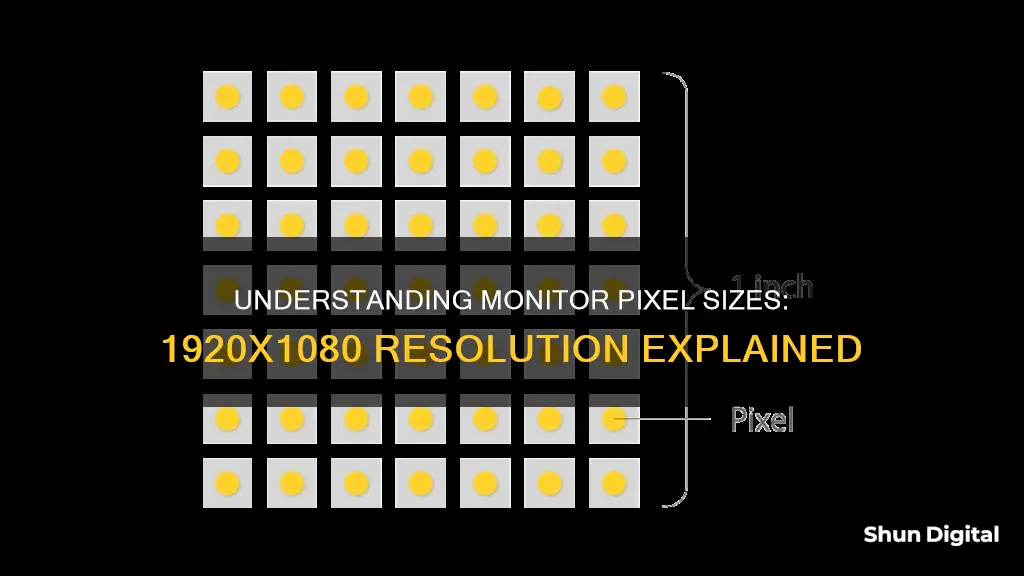
A monitor's resolution is an important factor to consider when purchasing a new one. The resolution of a monitor refers to the number of distinct pixels that can be displayed on the screen, impacting the sharpness and clarity of the image. A 1920x1080 monitor, also known as Full HD or 1080p, has a width of 1920 pixels and a height of 1080 pixels, resulting in a total of 2,073,600 pixels on the screen. This resolution is commonly used in modern displays and offers a sharp and clear viewing experience.
| Characteristics | Values |
|---|---|
| Number of Pixels | 1920 horizontal pixels and 1080 vertical pixels |
| Aspect Ratio | 16:9 |
| Total Pixels | 2,073,600 |
| Megapixels | 2.07 |
| PPI (pixels per inch) | Varies depending on screen size |
What You'll Learn

1920x1080 is Full HD or FHD
1920x1080, often referred to as 1080p, is a display resolution that equates to Full HD or FHD. This resolution is characterised by 1,920 pixels displayed horizontally across the screen and 1,080 pixels vertically. The 'p' in 1080p stands for progressive scan, meaning the image is displayed in a non-interlaced way.
Full HD or FHD is a ubiquitous resolution, found on many PC monitors, gaming laptops, and TVs. It is the lowest resolution that is considered acceptable for gaming or a modern computing experience. However, it is not as sharp as higher resolutions like 1440p or 4K.
Full HD has a total of over 2 million pixels, which is significantly less than the over 8 million pixels of 4K resolution. The higher the resolution, the sharper the image will be, as more pixels are packed into every square inch of the screen. However, when it comes to choosing a resolution, it's important to balance cost, quality, and energy efficiency. Full HD is likely to be cheaper and more energy-efficient than higher resolutions, and it will still look good on most screens, especially when streaming content online.
For gaming, a higher resolution will deliver more detailed and realistic images, but it will also be more demanding on your graphics card. Additionally, a higher resolution on a computer screen allows more space for window placement, increasing productivity. When it comes to monitor aspect ratios, the standard is 16:9, but there are also ultrawide monitors with aspect ratios of up to 21:9 or 32:9.
Deltek's Internet Monitoring: What You Need to Know
You may want to see also

FHD has a resolution of 2,073,600 pixels
FHD, or Full High Definition, is a display resolution standard that has become increasingly popular in recent years. FHD has a resolution of 1920 x 1080 pixels, which equates to a total of 2,073,600 pixels. This resolution is commonly referred to as 1080p, indicating the number of horizontal lines (1080) that form the image on the screen. The "p" in 1080p stands for progressive scan, meaning that each line of pixels is drawn sequentially from top to bottom, resulting in smoother images compared to interlaced scanning found in older display technologies.
FHD offers a significant improvement in image quality over its predecessor, HD (High Definition), which has a resolution of 1280 x 720 pixels. With a higher pixel count, FHD delivers sharper and more detailed images. The term "Full HD" refers to the fact that FHD screens have a vertical resolution of 1,080 pixels, enhancing the image quality and providing a more immersive viewing experience.
The aspect ratio of FHD is 16:9, meaning the width of the screen is 1.78 times its height. This widescreen format closely matches the dimensions of most movies and TV shows, making it the ideal aspect ratio for watching films and playing video games. FHD screens provide a more immersive viewing experience compared to other resolutions with different aspect ratios.
FHD is widely adopted and can be found in various electronic devices such as TVs, computer monitors, laptops, smartphones, and tablets. It offers an excellent balance between image quality and performance, making it a popular choice for consumers who want high-quality visuals without the high cost associated with higher resolutions. FHD displays are also more energy-efficient, resulting in reduced power consumption and a smaller carbon footprint.
In summary, FHD, with its resolution of 2,073,600 pixels, delivers sharp and detailed images while remaining compatible with a wide range of devices. Its widespread adoption and versatility make FHD a popular choice for consumers seeking an immersive viewing experience at an affordable price.
Monitoring Memory Usage: CloudWatch Strategies and Insights
You may want to see also

FHD is the standard resolution for television, internet streaming services, video games, and smartphones
FHD, or Full High Definition, is the industry standard for television, internet streaming services, video games, and smartphones. FHD offers a resolution quality of 1920x1080 pixels, which is often marketed as 1080p. This means that the screen has a width of 1,920 pixels and a height of 1,080 pixels, resulting in a total of 2,073,600 pixels on the screen.
FHD provides a sharp and detailed image with a higher pixel density compared to standard HD displays. This increased pixel density ensures that images and videos appear sharp and well-defined, making it ideal for larger screens and high-quality visual content. The higher resolution also allows for more screen real estate, enabling users to fit more content on the screen without sacrificing clarity. This can be particularly useful for professionals who need multiple windows or applications open at the same time.
The benefits of FHD are not limited to image quality. FHD displays are widely available and can be found in various devices, including TVs, monitors, laptops, and smartphones. This makes it easier to find content optimised for FHD resolution. Additionally, FHD content is widely supported across different platforms and devices, and it is the standard resolution for Blu-ray discs, streaming services, and most video content.
FHD also offers a cost-effective option for consumers. FHD displays are generally more affordable compared to higher-resolution options like 4K or 8K. This makes FHD a popular choice for those seeking a good balance between price and image quality. Furthermore, FHD displays consume less power compared to higher-resolution displays, resulting in longer battery life for laptops and smartphones.
In terms of performance, FHD delivers an enhanced gaming experience with sharper graphics and detailed visuals. Unlike 1080i, which has the same pixel resolution, FHD uses progressive scanning, which is better for motion and fast-moving content. This makes FHD ideal for video games and other applications that require smooth motion rendering.
While FHD is the current standard, it may become less common as technology advances and higher-resolution displays become more prevalent and accessible. However, FHD remains a popular option for everyday use, general computing tasks, and budget-conscious consumers seeking a balance between price and image quality.
Asus Monitors: Premium Price, Premium Performance?
You may want to see also

FHD is 1080p, which is a non-interlaced monitor resolution
FHD stands for Full High Definition, also known as Full HD. It is a display resolution with 1920 x 1080 pixels, meaning there are 1920 pixels horizontally and 1080 pixels vertically on the screen. This resolution, also known as 1080p, offers a sharp and detailed image with greater pixel density compared to standard HD displays. FHD is commonly used in TVs, monitors, laptops, and other devices.
FHD provides a high level of detail and clarity, resulting in a visually pleasing viewing experience. The increased pixel density ensures that images and videos appear sharp and well-defined. FHD displays are widely available and can be found in a range of devices, including TVs, monitors, laptops, and smartphones. This makes it easier to find content optimised for FHD resolution.
FHD is a non-interlaced monitor resolution, which means it is not scanned or displayed using interlacing – a method of displaying images where only every other line of pixels is displayed at once. Instead, FHD uses progressive scanning, where all the lines of pixels are displayed at the same time. This results in a higher-quality image with better motion handling and reduced flicker.
The benefits of FHD resolution include its wide availability, affordability, and compatibility with various platforms and devices. It is the standard resolution for Blu-ray discs, streaming services, and most video content. FHD displays also consume less power compared to higher-resolution displays, resulting in longer battery life for laptops and smartphones.
However, FHD may not provide the same level of immersion and visual impact as higher-resolution displays, especially on larger screens. As technology advances, higher-resolution displays such as 4K and 8K are becoming more prevalent, and FHD may become less common over time. Additionally, FHD may not offer enough detail for certain professional applications, such as video editing or graphic design, where higher resolutions are often preferred.
Double Monitor Setup: Same Size, Better Display?
You may want to see also

FHD is twice the size of HD (1280 x 720)
FHD, or Full HD, is a resolution of 1920x1080 pixels, which is twice the size of HD resolution, which is 1280x720 pixels. FHD provides a more precise and detailed image quality than HD. This is because FHD has a higher pixel density, meaning there are more pixels packed into every square inch of the screen.
The higher resolution of FHD allows for a more immersive viewing experience, making visuals appear more lifelike and vibrant. With FHD, you can expect enhanced colour accuracy, richer contrast, and improved detail in images and videos. This increased resolution is ideal for larger screens, such as TVs or monitors, where it enhances the visual experience.
FHD is also known as 1080p, indicating the number of vertical pixels on the screen. This resolution is commonly used for television, internet streaming services, video games, and smartphones. It is the current standard resolution for television and has been since 2011.
The aspect ratio of FHD is 16:9, which is the same as HD. This aspect ratio provides a widescreen viewing experience and is the international standard for all things related to high definition. It allows for better utilisation of screen real estate and is ideal for office use or content creation.
FHD is sometimes referred to as 2K, as it has roughly 2000 pixels of horizontal resolution. However, this is not entirely accurate, as 2K specifically refers to a resolution of 2048x1080 pixels. Despite this, the term 2K is often used interchangeably with FHD.
Easy Guide: Installing Audio Drivers for ASUS Monitors
You may want to see also
Frequently asked questions
A 1920x1080 monitor has a resolution of 1920 horizontal pixels and 1080 vertical pixels, commonly referred to as Full HD or 1080p. This resolution is standard for television, internet streaming services, video games, and smartphones.
1920x1080, also known as Full HD or 1080p, is considered the industry standard for monitors. It offers over twice the number of pixels of a 720p resolution, resulting in sharper and clearer images. Other common monitor resolutions include 1440p (2560x1440) and 4K (3840x2160).
A monitor's resolution impacts the sharpness and clarity of the display, with a higher resolution resulting in improved image quality. Additionally, a higher resolution allows for more viewable content on the screen and can enhance productivity by providing more space for window placement.







